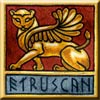
Cupra is a form of the Great Goddess of the Etruscans, equated to Juno or Uni. She was considered one of the Nine Great Gods who had the ability to throw thunderbolts (called by the Romans Novensiles), and was part of a triad with Tinia (Jupiter) and Menrfa (Minerva), who were said to have temples in every Etruscan city. Her origins are said to be Sabine, and She was worshipped among the Etruscans, Piceni, and the Umbrians (all located in central Italy). Cupra is a mother Goddess of fertility and the earth, of mothers and giving birth. Her name is thought to come from the Sabine word cuprum, which is usually glossed as "good". This word is likely derived from cup, "desire" (related to the Latin root of the name Cupid), making Her "good" in the sense that She is "the Sought After", or "the Desired One", implying a Goddess who fulfills wishes and answers prayers, or who is sought out because She is benevolent and powerful. As She is "good", She was equated with the Roman Goddess Bona Dea, literally "the Good Goddess". Her main temples were in the Etruscan cities of Veii, Falerii and Perusia, though there is also an Etruscan-built temple in Picenum, in east central Italy between the Adriatic and the Apennine mountains. The people called the Picenes were merchants of a warlike character whose totem bird was the woodpecker. Two cities in ancient Picenum were named for Her—Cupra Maritima, on the coast, and Cupra Montana, in the interior, Cupra Maritima being the older city (both of these cities retain the ancient names even now). In Her temple in Cupra Maritima, the Picentine assembly met in 542 BCE and agreed to ally themselves with the Etruscans to attack Cuma, indicating both that Her temple could properly be used as a civic meeting place, and that Cupra also had civic aspects to Her, much like Juno. Her temple was famed enough that it was later restored by the Emperor Hadrian in 127 CE. The modern Museum at Cupra Maritima has several bronze dedicatory plaques with inscriptions to Her. The town of Cupra Montana is located about 50 miles to the northwest and further inland, naturally enough in the mountains, and is known today for its grape festival. In the Umbrian town of Plestia, Cupra had a temple not far from where the church now stands, and where several other inscriptions to Her were discovered. Evidence of Her worship is found in another Umbrian town as well, Scgisa, demonstrating that She was worshipped by several neighboring tribes (of different languages), and was not purely local. She was sometimes confused with Feronia. Thalna may be an aspect of Cupra as midwife. She was also associated with Eileithyia (the Greek Birth-Goddess). Also called: Dea Cupra ("the Goddess Cupra"), Cupra Mater (Mother Cupra), Cubrar (Her Umbrian name), Ikiperu (Her Picene name). Alternate spellings: Kypra, Supra |
|
|



